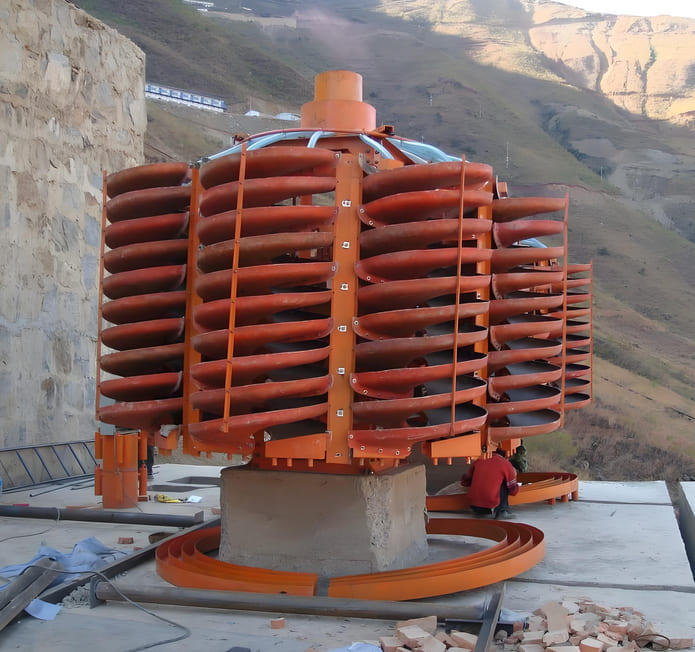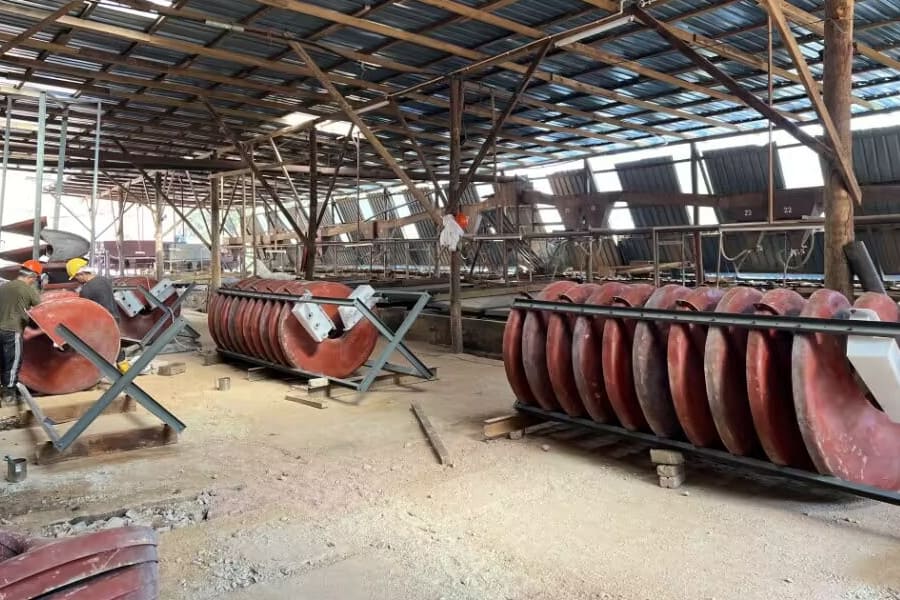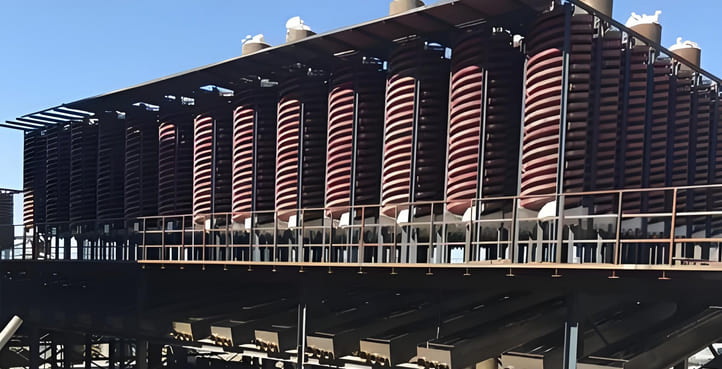The beneficiation effect of the spiral chute directly affects the technical and economic indicators of the beneficiation production line. Its separation efficiency determines the concentrate grade, metal recovery rate, and stability of the overall process. Good separation effect (such as optimizing pitch, concentration, and flushing water) can improve the grade of coarse concentrate (10%-30%) and recovery rate (60%-85%), reduce the load of subsequent concentration section (such as flotation, energy consumption, and drug consumption of shaking table), and reduce the loss of tailings metal; on the contrary, if the separation effect is poor (such as mud interference or parameter mismatch), it will not only increase the circulation of middlings and raise operating costs, but also may increase the remedial process (such as regrinding or secondary separating) due to excessive impurities in the concentrate, resulting in a decrease in production line efficiency. In addition, the low energy consumption characteristics of the spiral chute enable its application in pre-throwing or roughing sections to significantly reduce the power consumption of the entire plant, and the matching degree of its processing capacity (single unit 5-12t/h) and adapted particle size (0.02-2mm) also directly affects the continuity and scale economy of the production line. Therefore, its effect is one of the core links to achieve the “low cost, high recovery rate” beneficiation process. Let’s introduce the factors that affect the separation effect of the spiral chute and how to optimize its separation effect.

Factors Affecting The Separation Effect of Spiral Chute
Structural Factors
1. Spiral diameter (D)- Spiral diameter is a key parameter that determines equipment specifications and affects the selection of other structural parameters.
- When processing 1~2mm coarse-grained materials, it is advisable to use a large-diameter spiral of ф1000mm or ф1200mm or above.
- When processing fine-grained materials below 0.5mm, it is advisable to use a smaller diameter spiral.
- When processing 0.074~1mm materials, ф500mm, ф750mm, and ф1000mm spiral chutes can all achieve good results.
- The pitch determines the longitudinal inclination of the spiral trough, affecting the longitudinal flow velocity and flow layer thickness of the slurry.
- When processing fine-grained materials, the pitch is usually larger than when processing coarse-grained materials.
- In industrial equipment, the pitch-to-diameter ratio (h/D) is generally 0.4~0.8.
- The inner surface of the spiral chute for processing 2-0.2mm materials is usually elliptical with a ratio of long axis to short axis of 2:1-4:1.
- When processing materials below 0.2mm, the inner surface of the spiral trough is usually a cubic parabola, with a flat bottom and a wide separation zone, which is conducive to fine-grained separation.
- When processing easy-to-select materials, usually only 4 turns are required.
- When processing difficult-to-select materials or fine-grained materials (slime), it can be increased to 5-6 turns to extend the separation time and improve the separation effect.

Operational Factors
1. Feed concentration and feed amount
- When processing 0.2~2mm materials, the appropriate feed concentration is 10%~35% (solid mass fraction).
- When processing 0.2mm particle size materials, the appropriate feed concentration for the roughing operation is 30%~40%, and the appropriate feed concentration for the fine selection operation is 40%~60%. Under the appropriate concentration, the fluctuation of feed amount within a certain range has little effect on the selection index.
2. Flushing water volume
When processing 2~0.2mm materials, the fluctuation within the inner edge of the spiral trough often has no significant effect on the selection index.
The spiral chute generally does not add flushing water, which is different from the spiral concentrator.
3. Product discharge method
The separation products of the spiral chute are all discharged at the end of the spiral trough, and no intermediate discharge hole is set.
4. Feed properties
Feed properties include feed particle size, density difference between low-density minerals and high-density minerals in the feed, particle shape, and content of high-density components in the feed.
- Particle size: The suitable particle size range for sorting is 0.3~0.02mm.
- Density difference: The greater the density difference between low-density and high-density components, the better the sorting effect.
- Particle shape: affects the movement trajectory of mineral particles in the tank.
- High-density component content: Too high or too low content may affect the sorting efficiency.
Optimizing the Separation Effect of Spiral Chutes
The separation efficiency of spiral chutes plays a critical role in mineral processing plants, impacting metal recovery, concentrate grade, and overall economic performance. Building upon the analysis of factors affecting spiral chute performance, effective optimization measures are essential to maximize separation efficiency, concentrate grade, and recovery rates. Below are key strategies for enhancing spiral chute beneficiation outcomes through structural adjustments and operational improvements.
To maximize the beneficiation performance of spiral chutes, a balanced approach combining structural refinements and operational precision is essential. The selection of an appropriate spiral diameter – whether large (≥ф1000mm) for coarse particles or smaller (ф500–750mm) for fine materials – sets the foundation for efficient separation. Adjusting the pitch to match particle size ensures optimal slurry flow dynamics, with steeper inclinations better suited for fine particles to prolong separation time. The shape of the trough, whether elliptical for mid-sized particles or flat-bottomed parabolic for slimes, directly influences flow distribution and stratification efficiency. Additionally, increasing the number of spiral turns can enhance recovery rates for refractory or ultra-fine ores by providing additional separation cycles.
Beyond structural considerations, operational parameters such as feed concentration, particle size distribution, and pulp viscosity play a critical role. Maintaining a stable feed rate within the recommended 5–12 t/h range prevents turbulence while ensuring consistent throughput. Furthermore, periodic maintenance, such as inspecting trough wear and monitoring real-time separation metrics, helps sustain peak performance. When these measures are systematically implemented, spiral chutes not only improve concentrate grades and metal recovery rates but also reduce energy consumption and downstream processing costs. This holistic optimization transforms the spiral chute into a cornerstone of efficient, low-cost mineral beneficiation, aligning perfectly with modern production demands for sustainability and profitability.

Conclusion
The separation efficacy of spiral chutes hinges on synergistic structural and operational optimization. Tailoring diameter, pitch, and trough geometry to particle characteristics ensures efficient stratification, while controlled feed properties and flow dynamics enhance recovery rates. As a low-energy, high-capacity solution, optimized spiral chutes significantly reduce downstream processing loads and operational costs, cementing their role as a cornerstone of cost-effective mineral beneficiation. By systematically addressing the outlined factors, plants can achieve the dual objectives of “low cost, high recovery” in resource processing.
